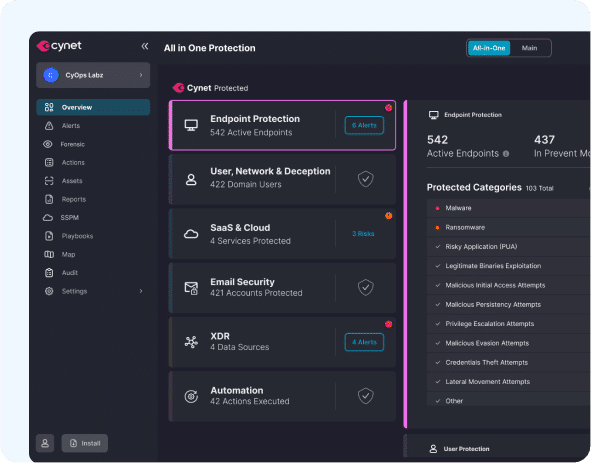Built for speed. Powered by simplicity.
Endpoint Security
Cynet delivers automated threat detection, investigation, and response in one simple platform—with advanced protection and 24/7 expert oversight.

Jump to Section

Top MITRE ATT&CK Performance
Cynet EDR continuously monitors endpoint devices to automatically prevent, detect and remediate threats. The EDR layer supplements EPP to uncover the stealthiest threats hiding on the endpoint. Cynet EDR goes beyond traditional endpoint offerings by combining signals across endpoints, networks, and users, along with deception technology to improve visibility, accuracy and protection across the entire attack surface.
Not a single vendor performed better than Cynet.
01
Endpoint protection is a core pillar of the Cynet platform. With industry leading performance proven in MITRE Engenuity ATT&CK Evaluations, Cynet EPP includes multiple prevention technologies to automatically stop ransomware, fileless malware, lateral movement, credential theft and zero-day exploits.

Next-Gen Antivirus (NGAV)
Uses AI Static and Behavioral Analysis to detect and stop threats—scanning files pre-execution with signature-based AV and machine learning, and terminating malicious processes at runtime.

Malware Protection
Multiple detection components, including memory patterns, signatures, file behavior, dll loading behavior, access to sensitive processes, etc.

Threat Intelligence
Use over 30 live feeds of various indicators of compromise to ensure your protections are always up to date with the latest threat intelligence.

Ransomware Protection
Unique logic to protect against a range of ransomware attacks.

Exploit Protection
Detect known attack patterns used to exploit 0-day vulnerabilities.

Critical Component Protection
Detect unexpected access to critical system components.

Memory Access Control
Ensure only legitimate processes can access critical areas in memory.

Fuzzy Hashing
Identify files with high similarity to known malware hashes.

Credentials Theft Protection
Protect against unauthorized access to user credentials.

Critical File & Documents Protection
Protect against unauthorized access to sensitive files and documents.

Device Control Monitor
Monitor, manage, and control access to USB storage devices.

MITRE ATT&CK Integration
02
Cynet EDR continuously monitors endpoint devices to automatically prevent, detect and remediate threats. The EDR layer supplements EPP to uncover the stealthiest threats hiding on the endpoint. Cynet EDR goes beyond traditional endpoint offerings by combining signals across endpoints, networks, and users, along with deception technology to improve visibility, accuracy and protection across the entire attack surface.

Windows Events Visibility
Visibility (in the forensics screen) to Windows Events that are automatically collected by Cynet. Customer cannot control which Windows Events are collected.

Full Environment Visibility
Detect even the most stealthy threats by automatically ingesting and analyzing native device, file, network, user, and deception telemetry feeds.

Automatic Remediation
Easily perform and automate remediation actions across the environment.

File & Process Events Monitoring & Logging
Log any file or process action so detail forensics data will be available.

Autonomous Detection and Response
Investigate and remediate 3rd party products like Firewalls or Active Directory.

Application and Endpoint Inventory
See all your hosts and the installed applications in your environment.

Memory Access Control
Create complex automatic investigation and remediation steps that will save you hours of manual work. See Cynet SOAR for more.

Active Directory Integration
Block, reset password, move users between security group as part of remediation process.

Network Visibility
Log and view Network events such as sockets for each host, user, process and files.
03
Cynet provides an additional layer of ransomware protection with extended visibility and protection across endpoints, networks and users. This uniquely allows Cynet to immediately detect ransomware at the beginning of its attack cycle. With the ability to automatically respond across critical environment components, Cynet can stop the ransomware process before files or drives are encrypted.

Windows Events Visibility
Visibility (in the forensics screen) to Windows Events that are automatically collected by Cynet. Customer cannot control which Windows Events are collected.

Full Environment Visibility
Detect even the most stealthy threats by automatically ingesting and analyzing native device, file, network, user, and deception telemetry feeds.

Automatic Remediation
Easily perform and automate remediation actions across the environment.

File & Process Events Monitoring & Logging
Log any file or process action so detail forensics data will be available.

Autonomous Detection and Response
Investigate and remediate 3rd party products like Firewalls or Active Directory.
04
Cynet ESPM (Endpoint Security Posture Management) provides proactive risk management for your company’s endpoints. By combining industry-leading threat detection with advanced risk mitigation capabilities, Cynet ESPM empowers organizations to quickly and easily identify and address endpoint vulnerabilities before they can be exploited.

Continuous Risk Scanning
Continuously monitor endpoints for both misconfiguration risks and unpatched binaries with known Common Vulnerabilities and Exposures (CVEs).

Risk Prioritization
Prioritize and categorize all identified risks with detailed context, including potential impact and relevant MITRE ATT&CK tactics and techniques.

Risk Reporting
Generate detailed reports on vulnerability risks across your organization, supporting informed decision-making and demonstrating compliance with security standards.

Mitigation Guidance
Provide suggestions on how to fix and mitigate each vulnerability identified, ensuring a proactive approach to security.